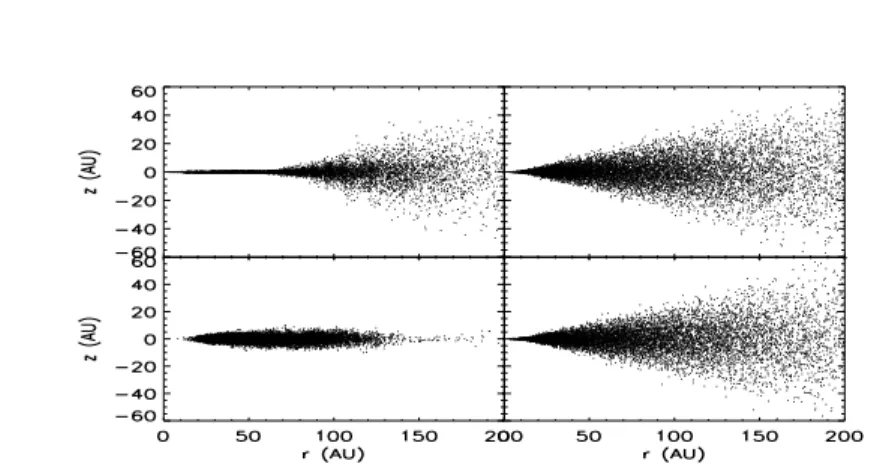HAL Id: hal-00000803
https://hal.archives-ouvertes.fr/hal-00000803
Preprint submitted on 31 Oct 2003
HAL is a multi-disciplinary open access
archive for the deposit and dissemination of sci-entific research documents, whether they are pub-lished or not. The documents may come from teaching and research institutions in France or abroad, or from public or private research centers.
L’archive ouverte pluridisciplinaire HAL, est destinée au dépôt et à la diffusion de documents scientifiques de niveau recherche, publiés ou non, émanant des établissements d’enseignement et de recherche français ou étrangers, des laboratoires publics ou privés.
Predicting Dust Distribution inProtoplanetary Discs
Laure Barrière-Fouchet, Jean-François Gonzalez, Robin Humble, Sarah
Maddison, James Murray
To cite this version:
Laure Barrière-Fouchet, Jean-François Gonzalez, Robin Humble, Sarah Maddison, James Murray. Predicting Dust Distribution inProtoplanetary Discs. 2003. �hal-00000803�
ccsd-00000803 (version 1) : 31 Oct 2003
**TITLE**
ASP Conference Series, Vol. **VOLUME***, **YEAR OF PUBLICATION** **NAMES OF EDITORS**
Predicting Dust Distribution in Protoplanetary Discs
L. Barri`ere-Fouchet, J.-F. Gonzalez
Centre de Recherche Astronomique de Lyon, ´Ecole Normale Sup´erieure, 46 all´ee d’Italie, 69007 Lyon, France
R.J. Humble, S.T. Maddison, J.R. Murray
Centre for Astrophysics and Supercomputing, Swinburne University, PO Box 218, Hawthorn, Victoria 3122, Australia
Abstract. We present the results of three-dimensional numerical sim-ulations that include the effects of hydrodynamical forces and gas drag upon an evolving dusty gas disk. We briefly describe a new parallel, two phase numerical code based upon the smoothed particle hydrodynamics (SPH) technique in which the gas and dust phases are represented by two distinct types of particles. We use the code to follow the dynamical evolution of a population of grains in a gaseous protoplanetary disk in order to understand the distribution of grains of different sizes within the disk. Our “grains” range from metre to submillimetre in size.
1. Introduction
The recent discoveries of extrasolar planets show our lack of knowledge about their formation, a multi-stage process taking us from dust grains to boulders to planetesimals to planetary embryos. Here we are primarily looking at the initial phase – from microns to metres.
In this paper we present the first three-dimensional numerical simulations that include the effects of hydrodynamical forces, self-gravity and gas drag upon an evolving dusty gas disk. We use the Smoothed Particle Hydrodynamics (SPH) (Gingold & Monaghan 1977; Lucy 1977; Monaghan 1992) technique which uses a collection of particles to approximate a fluid.
2. Parallel Tree and Multi-Phase SPH
We have written two slightly different SPH codes describing these multiphase fluids. One was developed by Robin Humble (Humble et al. 2004), the other was developed by Laure Barri`ere-Fouchet starting from James Murray’s code (Murray 1996). Gas and dust phases are represented by two distinct types of particles. The equation of motion is given by Maddison (1998).
The codes have been extensively compared and the main differences arise from the fact that Humble’s code allows higher resolution simulations and Barri`ere-Fouchet’s code seems to be able to simulate smaller size particles.
2 L. Barri`ere-Fouchet et al.
Figure 1. Dust (left) and gas (right) distributions in the meridian plane of the disk. Top: 10cm grains, bottom: 1mm grains.
3. Discussion
For large (10m) and small (µm) dust sizes, the dust distribution is expected to stay close to the initial flared disk. Large grains (boulders) are weakly coupled to the gas, and if started in Keplerian motion, they will remain there. Conversely, tiny grains are so strongly coupled to the gas that they are essentially co-moving (on the timescales we are examining here).
The 0.1mm to 10cm interval is where all the (short timescale) interesting dynamics takes place. In the r-z plot of figure 1, significant deviation from the initially flared disk occurs. The Epstein drag is sufficiently strong that it is able to efficiently remove energy from the dust, and yet not so strong that the dust is tightly coupled to the gas.
4. Summary
We have taken the initial steps to understanding dusty disk dynamics with full 3D hydrodynamics. The Lagrangian nature of the code means that it is compu-tationally trivial to add empirical grain growth models, to change equations of state, and to follow the grain temperature and density histories. This means it is potentially feasible to determine not just the location and mass of planetesimals, but also their likely composition.
References
Gingold, R. A., & Monaghan, J. J. 1977, MNRAS, 181, 375
Humble, R., Maddison, S. T., & Murray, J. 2004, MNRAS, in preparation Lucy, L. B. 1977, AJ, 82, 1013
Maddison, S. T. 1998, “Gravitational Instabilities in Protostellar Disks”, PhD Thesis, Monash University
Monaghan, J. J. 1992, ARA&A, 30, 543 Murray, J. 1996, MNRAS, 279, 402
